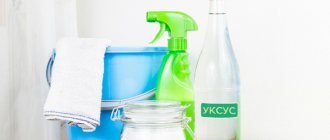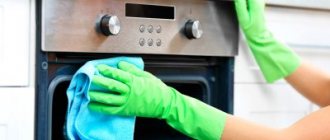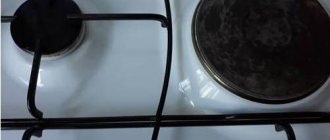Cooking in the oven is very convenient. There is no need to spend several hours at the stove; it is enough to set the desired temperature and observe the cooking time for a particular dish.
However, cleaning the oven compartment is a dubious pleasure; this part of the “stove” is subject to severe contamination, grease deposits and the formation of a dense burnt layer. It is not difficult for owners of a unit with a self-cleaning system to solve this problem, but what should those who have an ordinary stove installed in their kitchen do?
How to clean an electric oven without using harsh chemicals? There are many “folk” recipes.
How to clean an electric oven from grease and carbon deposits
The advantage of folk remedies is that they are harmless and do not cause allergic reactions. Of course, it’s easier to clean the oven using an advertised product, but it’s not safe. The fact is that it is impossible to completely remove aggressive substances from surfaces after cleaning, and during the cooking process, toxins and harmful fumes can get into the food. Therefore, it is better to use safer methods.
Pros and cons of processing
Cleaning the oven with any means has its advantages and disadvantages. The use of lemon and citric acid is no exception. Among the advantageous characteristics, one cannot fail to note such a fact as the removal of unpleasant odors. In addition, the treated surfaces acquire their original shine.
| Positive sides | Negative nuances |
| Naturalness of the product | Duration by time |
| Health safety | Several stages of work |
| Efficiency of the procedure | Airing from 3 to 4 hours |
| Ease of use | |
| Economical |
How to clean the oven with citric acid
To clean the oven, you can use either fresh citrus or a concentrated solution of lemon juice. The product can be used in three ways:
- Pour water into a heat-resistant bowl and add detergent, sliced lemon (or 1 pack of acid) and place the dishes in a preheated “broiler”. Boil the product inside the cabinet for 30–40 minutes, and when the “inside” of the stove has cooled, remove grease and soot with a sponge.
- Treat contaminated surfaces with a solution of lemon juice and water in a 1:1 ratio, or with citric acid dissolved in water. After half an hour, clean the oven and wash off any remaining product with warm water.
- Pour water acidified with lemon juice or acid into a spray bottle and thoroughly wet the walls and bottom of the oven compartment. After 40 minutes, wash off greasy marks and carbon deposits with warm water.
Dishwashing liquid
You can use dishwashing liquid instead of citric acid. Add about 50 ml of product to a bowl of water and heat the solution until it boils. Then go over the walls with the hard side of a sponge or a plastic spatula.
Visually, the process of cleaning the oven with citric acid and dishwashing detergent looks the same.
How to clean an electric oven with ammonia
An ammonia solution can remove heavy stains. You can use it in two ways:
- Apply ammonia to contaminated surfaces and leave for 8–10 hours, then wash them with dishwashing gel.
- Place a bowl of water in a “broiler” preheated to 100–120 degrees (on the bottom shelf), and a container with ammonia on the top shelf. Before installing the containers, the oven should be turned off.
- The door must be closed tightly and the products must be left inside for 10–12 hours.
- After this, wash the surfaces with a solution of 3 liters of water, 20 drops of ammonia and 2 tablespoons of dishwashing gel.
- Rinse the bottom and walls with clean water.
Ammonia works equally well with grease and soot.
Salt
Regular table salt can clean only mild stains. This method can be used regularly to keep the oven in order:
- cover grease stains with a thin layer of table salt;
- heat the oven at 150 degrees until the salt absorbs the melted fat and turns brown;
- Wash the oven with soap or dishwashing detergent.
Salt can be applied to the oven walls with a napkin.
8 ways to clean the oven with folk remedies
A mixture of soda, vinegar and citric acid
To clean the oven faster and easier, preheat it to 100–110 degrees. After that do the following:
- Prepare a cleaning solution from 1 package of lemon juice, a tablespoon of baking soda and 1⁄2 cup of vinegar.
- Apply the product to the surfaces, avoiding contact of the solution with the heating elements.
- After 20 minutes, rinse the compartment with clean water and wipe dry with a towel.
- After washing, the oven must be “aired” for 15–20 minutes.
Salt and acetic acid
To effectively clean the oven with these products, you must strictly follow the instructions:
- Add 1 kg of salt and 1 tablespoon of acetic acid to a container with 0.5 liters of water, dissolve the products, stirring the liquid.
- Place the cleaning solution in the preheated oven, preferably at the bottom.
- Preheat the product for 30 minutes, then turn off the oven, and after it has cooled, clean the surfaces with a sponge.
This product can be used to wash not only the bottom and walls, but also the door, grates and baking trays.
A mixture of baking soda and vinegar
Fatty deposits are sensitive to hydrogen, which is released during the interaction of components such as soda and vinegar. With the help of these products you can even deal with old stains. Follow this algorithm of actions:
- Wipe the oven compartment with a sponge soaked in vinegar.
- Sprinkle baking soda on a cloth or sponge and apply it evenly to the dampened walls. You can simply sprinkle the bottom and door.
- After 2-3 hours, remove the softened fat with a hard-bristle sponge.
When carbon deposits and traces of grease have been removed, wash the surfaces with warm water.
Baking powder for the dough
Baking detergent is no less effective at removing stains. How to clean the oven using baking powder? You need to do the following:
- Moisten the surfaces with a sponge or cloth;
- Sprinkle baking powder generously on the bottom and sides;
- After 2-3 hours, clean the “broiler” with a sponge and wash with clean water.
Under the influence of baking powder, streaks of grease and dirt roll off, forming soft lumps, and cleaning the surface will not take much effort.
Laundry soap
This method is completely safe, since laundry soap does not contain toxins or allergens. How to clean the oven:
- Grind 1⁄2 pieces of soap using a grater;
- add the pureed soap to a heat-resistant bowl with hot water, wait until the soap dissolves;
- Place a container with soap solution in a “broiler” preheated to 180 degrees;
- after 40 minutes, turn off the heating and wait for the surfaces to cool;
- Remove “acidified” fat and traces of soot using a sponge;
- Wash the surface with clean water.
After cleaning, leave the oven door open for 20–30 minutes to “ventilate” it from the specific alkaline smell of soap.
Vinegar essence
Vinegar concentrate will help remove even heavy stains without damaging the surface. The work is performed in this order:
- Soak a foam sponge with essence.
- Wipe down all surfaces, including baking sheets and racks.
- After 2-3 hours, clean with a sponge and remove any remaining vinegar.
Since vinegar is caustic, use gloves to avoid damaging your hands.
Baking soda
Using soda, you can tidy up not only the walls and bottom, but also the glass door of the oven compartment. Cleaning is carried out as follows:
- Wet surfaces with a damp cloth or dish sponge.
- Sprinkle the sides, bottom and door generously with baking soda.
- Spread the powder over the surfaces using a stiff bristled sponge.
- Leave the “stove” to soak for 1–1.5 hours.
- Wash off traces of soot and grease with a rag, remove any remaining soda with clean water.
- After cleaning, leave the frypot door open for a while to allow the surfaces to dry.
Salt
Salt tends to absorb fat, and cleaning the oven with it will not be difficult. You can do it like this:
- Sprinkle salt on the surfaces and distribute it evenly on the baking sheet.
- Place the baking sheet inside and preheat the oven until the salt turns golden brown.
- When the “stove” has cooled, wash the surfaces with water and detergent, and then with clean water.
To avoid burning, stir the salt on the baking sheet occasionally. If cleaning the oven the first time using one of the above methods did not work, repeat the procedure.
Eliminating unpleasant odors after cleaning
Very often, even after thoroughly and repeatedly rinsing the inner surface of the oven, a characteristic smell of the cleaning composition may be felt. What to do in this case:
- Depending on the degree of pungency of the odor, leave the oven door open for several hours or overnight;
- Dissolve 10-15 activated carbon tablets in a small amount of water and preheat the oven with the solution inside. Coal absorbs unpleasant odors;
- Wipe the oven walls with water and lemon juice;
- Cut a large onion in half and rub the inside cavity with a fresh cut. Onion juice will kill the smell of the cleaning product, and then quickly evaporate.
And finally. As always, the rule of thumb is that the best care is prevention. And, no matter what method of dealing with grease and carbon deposits you choose for yourself, under no circumstances should you ever apply the product to heating elements or a fan. Otherwise, you will never get rid of its smell. You can only wash the grill, guides, baking trays, door and walls themselves.
The article was written for the site.
Tags:Oven, Kitchen oven, Cleaning
Steam cleaning method
You can clean the oven using a steam generator, but if you don’t have one, use an alternative method:
- Pour water and 2 tablespoons of dish gel into a baking tray or deep roasting pan.
- Preheat the oven to a temperature of 150–180 degrees and place a container of water inside.
- After 30–40 minutes, turn off the heat and wait until the stove cools down.
- Wash off softened dirt with a foam sponge or cloth.
Do not use hard scouring pads, as this may cause scratches and the surfaces will become much more dirty in the future.
Electric and gas: are there any special features in cleaning?
Both electric and gas ovens require regular cleaning. In electric models, the self-cleaning function at high temperatures can be of great help, which is not the case in gas models.
Another feature of gas ovens is faster contamination due to the settling of soot from the burnt gas. Such cameras require more intensive processing.
The type of material used for the interior panels should also be taken into account. You can find out how to clean an electric oven here, and how to clean a gas oven here.
Safety precautions
Of course, cleaning the oven is not the most exciting event in your life, but you still have to follow certain safety precautions:
- carry out all actions only with rubber gloves - the products used can harm your skin or cause an allergic reaction;
- remove all racks and baking sheets from the oven - you can get caught on them in the process and damage your finger, and cleaning will become easier;
- open a window or window, turn on the hood - no matter how pleasant the smell of your product, it is better not to inhale it;
- children and animals should not be present in the kitchen while cleaning - this minimizes the risk of spreading household chemicals throughout the room and inhaling harmful fumes;
- refuse aggressive detergents - molecules with abrasive particles penetrate the inner walls of the cabinet and can settle on food when heated;
- use a respirator - it will prevent various chemicals from entering your body.
To improve the quality of cleaning, it is recommended to first heat the oven to 50 degrees. This will make it easier to remove the oldest stains and stubborn dirt. Afterwards, do not rush to close the door: the water inside will dry out faster and the cabinet will be ready for use again.
And most importantly, do not forget to turn off the power to the equipment before starting cleaning. Without this, any manipulation with it is fraught with electric shock.
Prohibitions
To ensure that cleaning does not lead to negative consequences, it is important to remember a number of prohibitions. These include:
Do not clean with abrasive sponges or metal scrapers, as this may damage the surface itself.- Do not use household chemicals for treatment that are not intended for this purpose. Violation of this rule can lead to damage to internal surfaces and harm your health.
- Cleaning products should not be left on for very long periods of time beyond the manufacturer's recommendations.
- You cannot use several household chemicals at the same time. By reacting with each other, they can give an unpredictable effect and cause serious harm to health.
Recommendations
Expert advice will help you cope with oven cleaning as easily as possible:
- Before cleaning, remove all baking sheets and racks from the oven.
- It is recommended to clean the oven with good ventilation - with the hood on and the windows open.
- If after using the oven there are splashes of grease and stains left on it, they must be removed immediately, without waiting until they dry out and become difficult to remove.
- Household cleaning products can only be applied to a cooled surface.
- If you remove the door first, cleaning the oven using mechanical methods will be easier.
- Some baking sheets can be washed in the dishwasher, which makes cleaning much easier.
- The fan can only be washed with soapy water.











